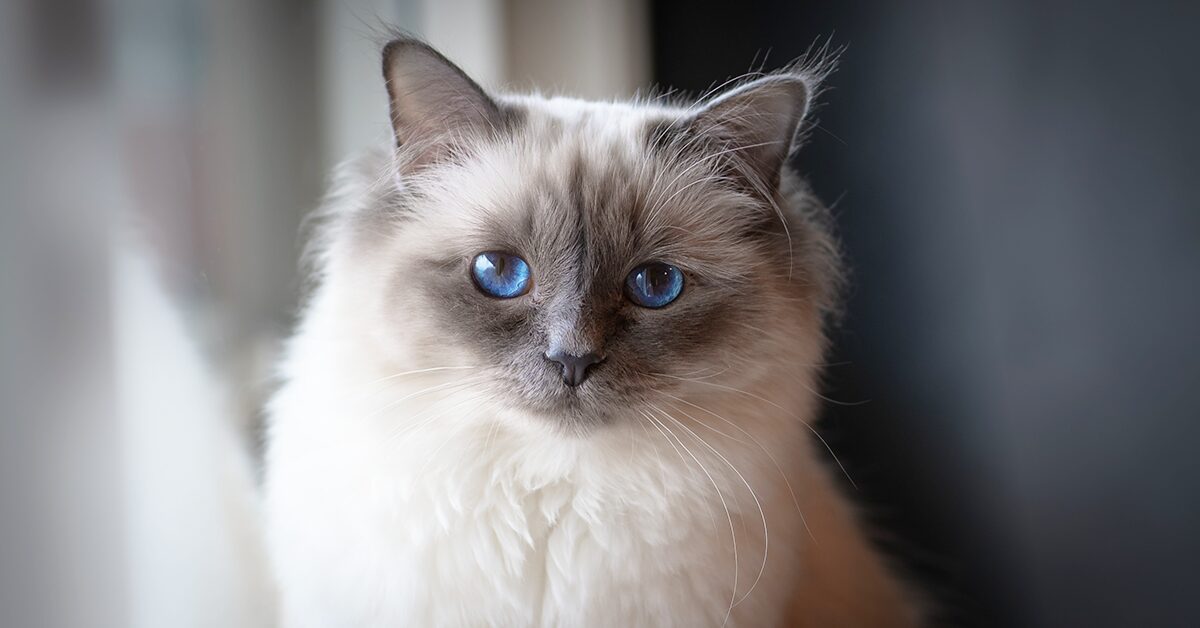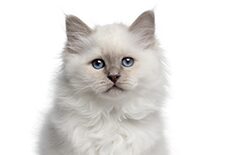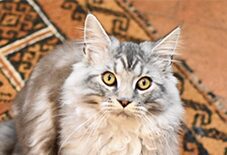
Meet the Birman
Stunning Sweetheart
Loving Feline
Companion Kitty
Once we catch your eye, we Birmans will melt your heart. Sweet as a flower and cuddly as can be, we’re as close to purrrfect as a kitten can get. And our appearance matches our purrsonality! With our soft and luscious cream coat color and sapphire blue eyes, we're especially beautiful. We’re also sociable and docile making us ideal family pets. We get along well with other pets and kids, and we’re always ready to curl up in your arms while you watch TV or snuggle up at bedtime.
Despite our adorable laziness, we do have a playful side. We like to chase balls and play fetch, but we don’t need a ton of exercise. What we do need a ton of, however, is attention. If our humans shower us with lots of love, cuddles, and praise, then we’re sure to be pretty happy felines.
Ready to learn more about me? Let’s dig in.
Ready to learn more about me? Let’s dig in.
 My Many Looks
My Many Looks

Cream

Beige

Tan

Cream tabby point
 My Breed Characteristics
My Breed Characteristics
 Furbulous Fact
Furbulous Fact
One of our claims to fame is iconic designer Karl Lagerfield’s Birman cat named Choupette. Not only did Choupette get to travel the world on a private jet, but Lagerfield actually designed a line of cat-themed accessories inspired by his stunning sidekick (Choupette was even featured in a few ads!). While Lagerfield has sadly passed away, Choupette still lives in Paris with her own personal agent. Move over, Beyonce!
 As I Grow Up
As I Grow Up
As you can see, we Birmans age pretty gracefully. Here are a few key milestones in my growth & development to be aware of as I grow up from a kitten, to an adult, to a senior!

Kitten < 3 years
As newborns, we must spend a bit longer with our mothers to become socialized. We’ll be ready for our furever homes in 12 to 16 weeks.

Adult3-9 years
While our silky coats don’t require daily care, we do love to be groomed. Brush our coats once a week and clip our claws monthly.

Senior9-16 years
We’re a healthy breed, but we’re prone to obesity as we age. Make sure you feed us a nutritious diet to keep us happy and healthy.
 History of My Breed
History of My Breed
We don’t like to brag, but if you think our beauty is near godly, then you might be right. They call us the Sacred Cat of Burma, and legend has it that we inherited our deep blue eyes from a blue-eyed goddess, who gave us this gift to reward a temple cat for his devotion to his Kittah priest. Legend has it that this goddess gave us blue eyes, turned our coats golden, and kept our white paws white (as a symbol of our purity). They say now that priests who died were reborn into Birman cat bodies (which we can’t confirm or deny).
Legends aside, it’s unclear how we really came to be. Theories suggest that we’re a cross between Siamese cats, Angora cats, or Persian cats, but really, we’re not sure. What we do know, however, is that we were imported to France when two Europeans - Auguste Pavie and Major Gordon Russell - were given a pair of Birmans in 1919 as a reward for helping priests. Sadly, the male of the pair died before making it to France, but not before he impregnated the female. Thus, the Birman bloodline was born.
But getting to where we are now was no easy feat. During World War II, we were nearly wiped out. They say only two Birmans remained when the war ended! Over time, we made a comeback, and in 1959 we were imported to the United States. In 1967, we were officially recognized by the Cat Fanciers Association (CFA). Today, we are beloved and beautiful family pets; we’re playful, affectionate, and totally adorable. And that’s no legend - we really are that purrfect.
 Pawesome Cats to Parent
Pawesome Cats to Parent
In addition to purebred Birmans like me, there are tons of purrfectly sweet mixed-breed Birmans that are looking to find their furever homes. You can learn where to find your next pet below!
 Care Tips
from Dr. Sara Redding Ochoa, DVM
Care Tips
from Dr. Sara Redding Ochoa, DVM 
Make sure you brush your cat daily.
Birman cats have long hair that is very silky, which can easily tangle and develop mats. By brushing your Birman cat each day, you can maintain their fur and skin health while bonding with your furry friend.
Get your Birman genetically tested.
Birman cats that are well-bred do not have many health issues. However, if your kitten’s parents have not been tested for cardiomyopathy, potential health complications could arise. Make sure you test your Birman to ensure that they are as healthy as can be.
Kick up the exercise!
Birman cats are a very playful and loving cat breed. They do best with a family that loves to play and give them plenty of attention. Make sure that you spend time each day playing with your Birman cat to help keep them happy and healthy.

 Why Get Cat Insurance?
from Pumpkin®
Why Get Cat Insurance?
from Pumpkin®
While Birmans are a generally healthy breed, cat-astrophes can happen to any cat at any age. If your kitty gets hurt or sick, pet insurance can help you say ‘yes’ to the best care, even when it’s costly. When it comes to shopping for this breed, you’ll want to choose insurance plans like Pumpkin's, which can help cover the costs associated with the hereditary conditions Birmans are prone to developing. While a reputable breeder will conduct genetic testing on your kitty’s parents to help minimize the chances of passing down hereditary conditions, they can’t always be avoided. Let’s look at some common ones, and how Pumpkin Cat Insurance plans could help cover the cost of care!
 Hypertrophic Cardiomyopathy
Hypertrophic Cardiomyopathy
Birmans may develop genetic heart problems, specifically a condition called Hypertrophic Cardiomyopathy (HCM). With this, the walls of the heart muscle thicken, which causes a decline in cardiac function. While there is no cure, heart disease can be managed with medication and dietary changes.
- Cost to Treat
- $500-$3,000 (surgical)
- Pumpkin Plans Pay Back*
- $450-$2,700
 Hip Dysplasia
Hip Dysplasia
Some Birmans develop hip dysplasia. This occurs when the hip joint’s ball and socket doesn’t develop or work properly, causing joint deterioration, pain, lameness, and/or arthritis. While mild cases are treated with prescription meds and physical therapy, severe ones require surgery.
- Cost to Treat
- $200-$2,500
- Pumpkin Plans Pay Back*
- $180-$2,250
 Periodontal Disease
Periodontal Disease
This breed is prone to periodontal (gum) disease, which occurs when plaque builds up and forms tartar that inflames the gums. If left untreated, gums weaken and separate from teeth. While routine brushing, cleanings, and antibiotic gels help treat milder cases, severe ones require surgery.
- Cost to Treat
- $400-$1,200
- Pumpkin Plans Pay Back*
- $360-$1,080
 Polycystic kidney disease
Polycystic kidney disease
PKD is a genetic kidney disease that can occur in Birmans, characterized by the growth of cysts on the kidneys. As it progresses, the kidneys are more prone to infection and failure. Drainage of cysts, low protein diets, and Vitamin D supplements are used to slow the disease’s progression.
- Cost to Treat
- $3,000-$6,000
- Pumpkin Plans Pay Back*
- $2,700-$5,400
*Example illustrates reimbursement of a covered vet bill at a 90% reimbursement rate, where the annual deductible had already been satisfied and the annual limit had not yet been met. Coverage and reimbursement results vary based on policy options.




